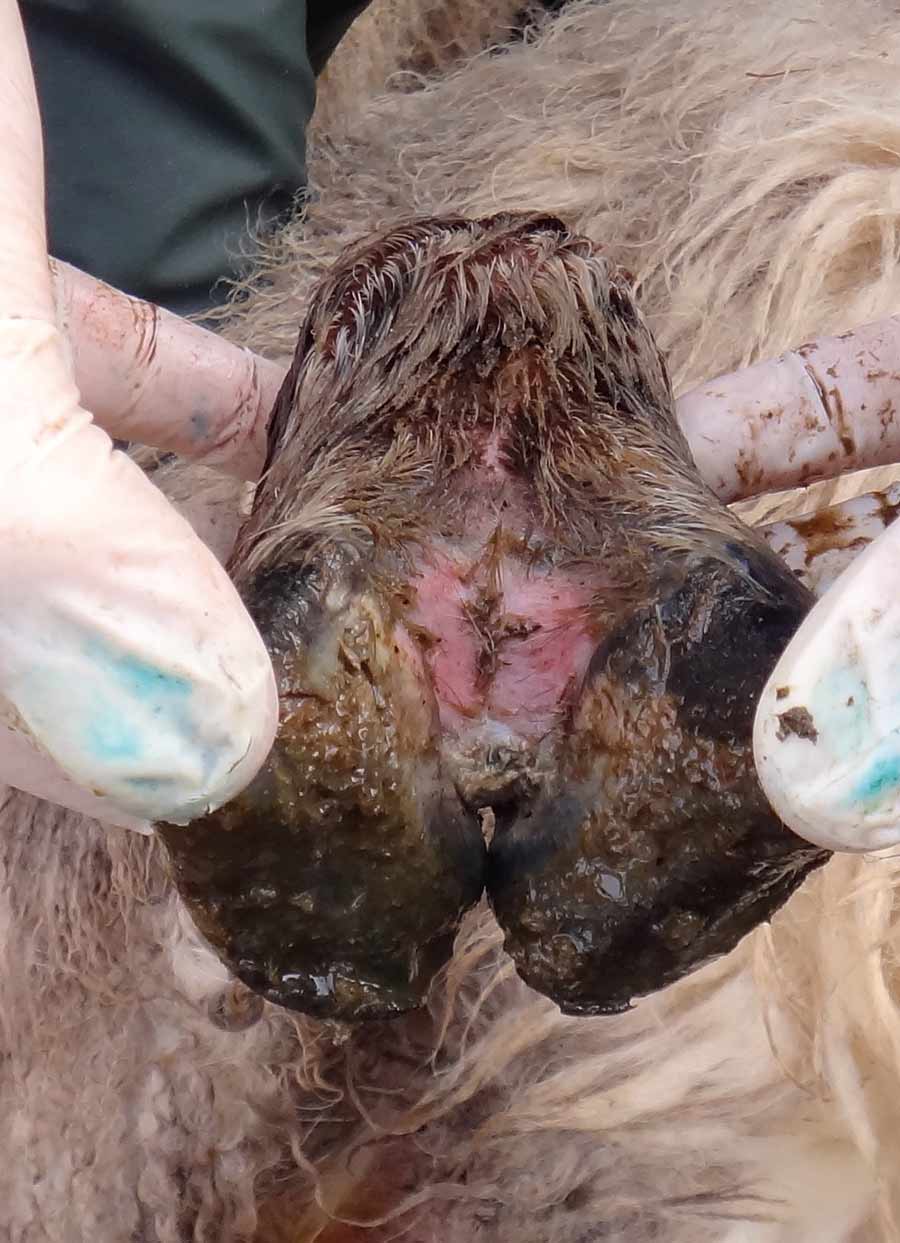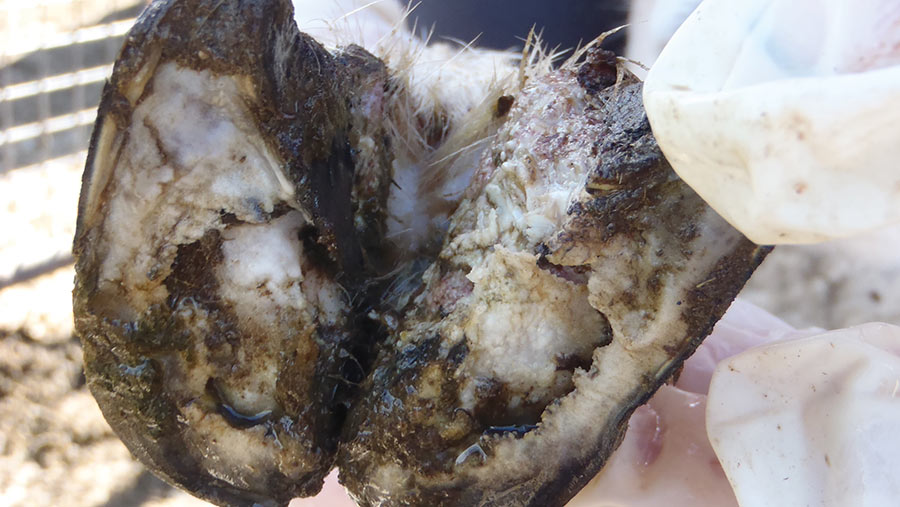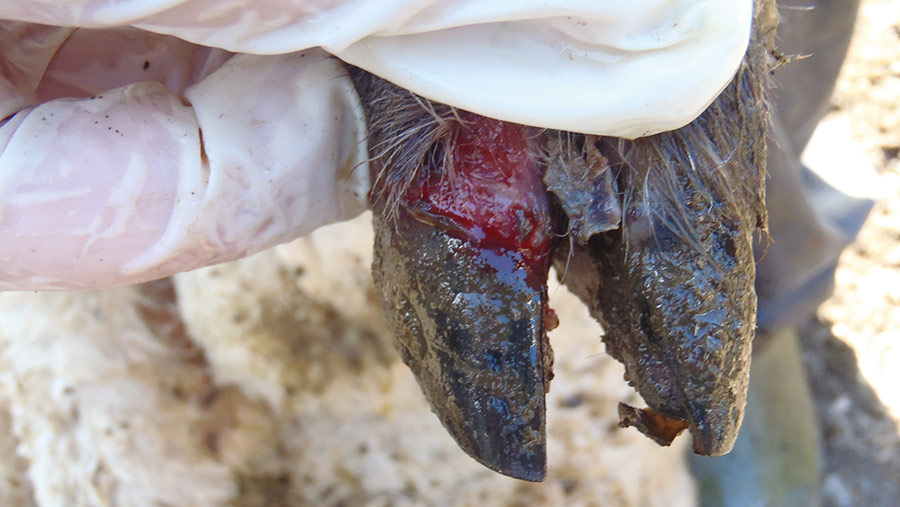Foot-rot link to Codd could help control disease in sheep
 © Tim Scrivener
© Tim Scrivener Research into the relationship between contagious ovine digital dermatitis (Codd) and foot-rot showed that when Codd was introduced into flocks with healthy feet, 83.3% of Codd lesions developed in feet previously infected with foot-rot.
This was one of the findings of a study carried out to improve understanding of what causes Codd and how it is currently diagnosed, treated and controlled.
Speaking at an AHDB webinar (28 September), Jennifer Duncan, vet, researcher and senior lecturer in livestock health and welfare at the University of Liverpool, said: “We need to repeat this [work] in the field, but it is consistent with previous studies.”
See also: Survey identifies most problematic sheep and cattle diseases
The research, which involved scientists, farmers and vets, also showed Codd was more prevalent in large flocks, lowland pasture and lush pasture.
The reasons for this are unclear, says Dr Duncan, but frequent moves of sheep, higher stocking rates and wet and muddy conditions may be contributory factors.
What is Codd?
Codd is a severe and painful infectious bacterial foot disease that now affects at least half of flocks in England and Wales.
It causes a sore, red area near the junction of the horn and the skin of the leg. Infection gradually moves downwards, damaging the bones inside the hoof and pushing the hoof capsule right off.
With treatment, the foot does heal – the surface of the horn grows a fresh covering and starts to harden – but often ends up a bit deformed and stumpy.
The biggest peak of infection occurred in late summer and early autumn, possibly because of warm, wet conditions and/or high stocking rates causing a build-up of bacteria. A smaller peak was seen in late spring and early summer.
Cause
Codd is caused by a mix of bacterial infections. Treponeme bacteria are found all the time in feet affected by Codd, says Dr Duncan.
They appear to be similar to those causing digital dermatitis in cattle and goats, but more work is needed to confirm this.
Dichelobacter nodosus and Fusobacterium necrophorum, which cause foot-rot, are also commonly found.
Diagnosis
Mixed infections of Codd, scald and foot-rot are often seen within flocks and even in individual animals, which can make diagnosis difficult (see images below).
If in doubt, farmers should ask their vet for help. Dr Duncan hopes her ongoing research will produce a formal diagnosis.

Scald/interdigital dermatitis/benign foot-rot: Red area with white, slimy material in the interdigital space © Jennifer Duncan

Foot-rot: Cheesy-smelling infection moves from inside outwards and shows as a circular pattern across the claws © Jennifer Duncan

Codd: Inflammation starts at the coronary band and progresses downwards, with a sweeter smell than foot-rot © Jennifer Duncan
Impact
Many different infections were examined and scored for lameness as part of the research.
Sheep with Codd scored much higher for lameness than for those with scald or foot-rot, and, if there was a mixture of disease in one sheep, higher still.
Treatment
Codd is very treatable with antibiotics. A farm-specific treatment plan drawn up with the farm vet will ensure that the most appropriate antibiotics, used at the correct dosage and for the correct amount of time, are prescribed. In general, penicillins and macrolides work best.
“We found one dose of amoxicillin gave 40 hours of protection, so a single dose [often] isn’t enough to cure a foot. It could take two, three or four doses,” says Dr Duncan. “It’s really important to treat until the foot is healed.”
Treating as soon as possible, aggressively and thoroughly, is obvious from an animal welfare point of view, she adds, but the sooner treatment begins, the less damage is caused, the quicker the recovery and the lower the rate of infection on farm.
The research was funded by AHDB, Hybu Cig Cymru, Biotechnology and Biological Sciences Research Council and Animal Welfare Foundation.
Codd control checklist
- Work with your vet to establish the correct diagnosis, discuss the risk factors particular to your farm and produce a treatment plan
- Isolate affected sheep and weigh them to determine the correct dose of antibiotics
- Treat promptly with antibiotics until the foot is healed
- Use pain relief, otherwise growth rates and mothering ability may be affected
- Avoid hoof-trimming as there is no evidence that this helps treat Codd
- Improve hygiene to keep the bacterial load down by avoiding wet and muddy areas outdoors and keeping bedding clean and dry.
- When handling sheep, use antibacterial soap, ethanol, or disinfectant such as Fam 30 or Vikron, all of which kill Trepaneme bacteria
- Control Codd and foot-rot together
- Tighten biosecurity: isolate any sheep coming onto the farm for four weeks and check their feet. Not all sheep with Codd are lame so they must all be checked
- If treatment is not effective, go back to your vet
- Consider culling for recurrent lameness
